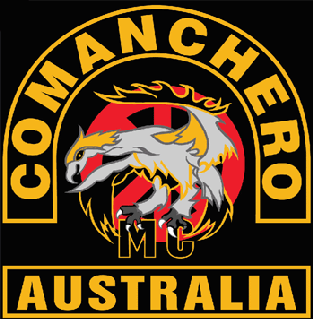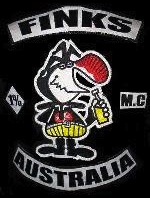Related Research Articles

The Bandidos Motorcycle Club, also known as the Bandido Nation, is an outlaw motorcycle club with a worldwide membership. Formed in San Leon, Texas, in 1966, the Bandidos MC is estimated to have between 2,000 and 2,500 members and 303 chapters located in 22 countries, making it the second-largest motorcycle club in the world behind the Hells Angels.
The Milperra Massacre, Milperra bikie shoot-out or Father's Day Massacre was a gunfight between rival motorcycle gang members on 2 September 1984, in Milperra, a south-western suburb of Sydney, New South Wales. The gunfight had its roots in the rivalry that developed after a group of Comancheros broke away and formed the first Bandidos Motorcycle Club chapter in Australia. Seven people were killed and twenty-eight injured and the event was a catalyst for significant changes to gun laws in New South Wales.
Lindsay Jane Simpson is an Australian journalist, university teacher and a writer of true crime.
Organised Crime and Gangs in Australia refers to the activities of various groups of crime families, organised crime syndicates or underworld activities including drug trafficking, contract killing, racketeering and other crimes in Australia.

The Comanchero Motorcycle Club is an outlaw motorcycle gang in Australia and South East Asia. The Comancheros are participants in the United Motorcycle Council of NSW, which convened a conference in 2009 to address legislation aimed against the "bikie" clubs, their poor public image in the wake of several violent clashes and ongoing biker wars, and defusing deadly feuds such as the Comancheros' battles with the Hells Angels. The sincerity of these efforts to defend the battered image of the clubs has been met with skepticism.

The Finks are an Australian outlaw motorcycle club that was formed in Adelaide, Australia, in 1969 and now also has chapters in other states. The name comes from The Wizard of Id cartoon where the peasants, to his dismay, often proclaim, "The King is a fink!". The logo used by the Finks is of Bung, the king's jester. The pants worn by the jester used to differ in colour depending on the state the chapter resides in.
The history of gangs in Australia goes back to the colonial era. Criminal gangs flourished in The Rocks district of Sydney in its early history in the 19th century. The Rocks Push was a notorious larrikin gang which dominated the area from the 1800s to the end of the 1900s. The gang was engaged in running warfare with other larrikin gangs of the time such as the Straw Hat Push, the Glebe Push, the Argyle Cut Push, the Forty Thieves from Surry Hills, and the Gibb Street Mob.

The Rebels Motorcycle Club is an outlaw motorcycle club. At its peak in Australia, it had around 70 chapters and over 1,000 members and associates nationwide, making it the largest club in the country at the time. It was founded by Clint Jacks in Brisbane, Queensland, in 1969 and was originally named the "Confederates". Their insignia is a Confederate flag with a cap-wearing skull and 1% patch in the centre. The Australian government and law enforcement consider the Rebels to be a criminal organisation, but the club claims to be a group of motorcycle enthusiasts rather than gangsters.
Bikie Wars: Brothers in Arms is a six-part Australian drama miniseries about bikie gang violence, screened on Network Ten on 15 May 2012. Bikie Wars is based on the book Brothers in Arms by Lindsay Simpson and Sandra Harvey. The screenplay was written by Greg Haddrick, Roger Simpson and Jo Martino. It is directed by Peter Andrikidis. Bikie Wars: Brothers in Arms cost A$6,000,000 to make.

The Nomads Motorcycle Club is an outlaw motorcycle club in Australia with a large number of chapters and members nationwide. It was founded in Newcastle in 1968. A number of countries have motorcycle clubs called "Nomads Motorcycle Club", e.g. Australia, South Africa and Germany, and there is a Nomads gang in New Zealand.
Philip McElwaine is an Australian boxer and motorcycle club member. He was born in Maitland, New South Wales. He competed at the 1976 Summer Olympics in Montreal. He was the Middleweight Gold medalist in the 1978 Commonwealth Games.
Mahmoud "Mick" Hawi was a Lebanese-Australian outlaw biker and gangster who served as the second national president and "supreme commander" of the Comanchero Motorcycle Club.
Notorious is a former gang that was based in Sydney, Australia. They claimed to be an outlaw motorcycle club; however, not all members ride motorcycles. A large percentage of its membership consisted of petty criminals, with no real history of bikers among their ranks. Its emblem features a skull with a turban brandishing twin pistols and the words "Original Gangster" beneath it, along with the motto "Only the dead see the end of war". Labeled as one of Australia's most dangerous gangs, they had been feuding with larger and well-known motorcycle gangs including the Hells Angels and the Bandidos. It was thought that as of March 2012 the gang no longer existed as an organised structure after being dismantled by a police operation arresting key members and with other members choosing to quit the gang life. This served to reinforce claims by established MCs that Notorious wasn't a genuine club.

The Red Devils Motorcycle Club (RDMC) is an international outlaw motorcycle club and the principal support club of the Hells Angels. The club is not to be confused with the now-defunct Original Red Devils Motorcycle Club that was founded in Canada in the late 1940s.
The Bandidos Motorcycle Club is classified as a motorcycle gang by law enforcement and intelligence agencies in numerous countries. While the club has denied being a criminal organization, Bandidos members have been convicted of partaking in criminal enterprises including theft, extortion, prostitution, drug trafficking and murder in various host nations.
The Rock Machine–Rebels conflict is an ongoing conflict between the Rock Machine and Rebels motorcycle gangs in Perth, Western Australia. The conflict began in 2009 and has continued sporadically, with both clubs competing for territory and control of criminal rackets.
The Hells Angels Motorcycle Club (HAMC), an international outlaw biker gang, has been involved in multiple crimes, alleged crimes, and violent incidents in Australia. The Hells Angels are legally classified as a criminal organisation in the Australian state of Queensland, and there have been attempts to classify them as such in New South Wales. The Hells Angels have been linked with drug trafficking and production, as well as a host of violent crimes including murder, in Australia.
William George "Jock" Ross is a Scottish-born Australian outlaw biker, best known as the founder and the "Supreme Commander" of the Comanchero Motorcycle Club and for his involvement in the Milperra massacre of 1984. Ross was sentenced to life imprisonment with Judge Roden childing him as one of the men most responsible for the shoot-out at the Viking Tavern.

Anthony Mark Spencer was an Australian outlaw biker noted for his role in the Milperra massacre of 1984.
References
- 1 2 3 4 5 6 Simpson & Harvey 2012, p. 31.
- ↑ Simpson & Harvey 2012, p. 85.
- 1 2 3 4 5 6 7 8 9 Kent, Paul (28 August 2010). "This old bikie never gives up the fight". The Daily Telegraph. Retrieved 21 December 2022.
- ↑ Simpson & Harvey 2012, p. 32.
- ↑ Simpson & Harvey 2012, p. 35-36.
- ↑ Simpson & Harvey 2012, p. 37.
- 1 2 Simpson & Harvey 2012, p. 54.
- ↑ Simpson & Harvey 2012, p. 223.
- ↑ Simpson & Harvey 2012, p. 94-95.
- ↑ Simpson & Harvey 2012, p. 95.
- ↑ Simpson & Harvey 2012, p. 99.
- ↑ Simpson & Harvey 2012, p. 99-100.
- 1 2 3 4 Simpson & Harvey 2012, p. 100.
- ↑ Simpson & Harvey 2012, p. 101.
- ↑ c, Edmund (22 February 2009). "My brothers died, for what? They were just at the wrong place at the wrong day'". The Sydney Morning Herald. Retrieved 12 November 2023.
- ↑ Simpson & Harvey 2012, p. 111.
- ↑ Simpson & Harvey 2012, p. 112.
- ↑ Simpson & Harvey 2012, p. 127-128.
- ↑ Simpson & Harvey 2012, p. 128.
- ↑ Simpson & Harvey 2012, p. 156-157.
- ↑ Simpson & Harvey 2012, p. 177.
- ↑ Simpson & Harvey 2012, p. 180.
- ↑ Simpson & Harvey 2012, p. 224.
- ↑ Simpson & Harvey 2012, p. 241-243.
- ↑ Simpson & Harvey 2012, p. 243.
- 1 2 Simpson & Harvey 2012, p. 244.
- ↑ Simpson & Harvey 2012, p. 257.
- ↑ Gridneff, Ilya (22 May 2012). ""Yanking My Chain: Bikie Blasts Milperra TV Series"". The Canberra Times. Retrieved 12 November 2023.